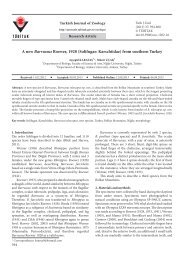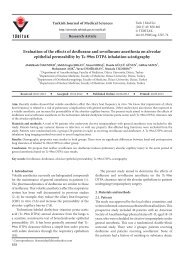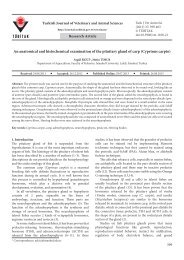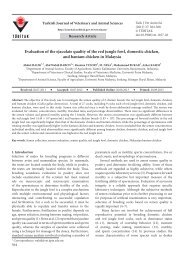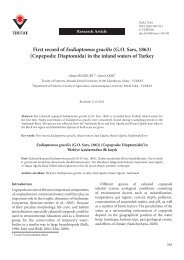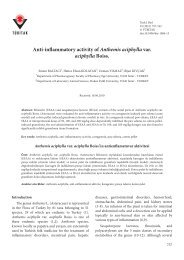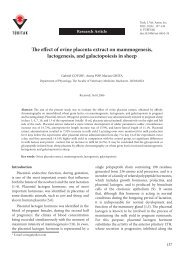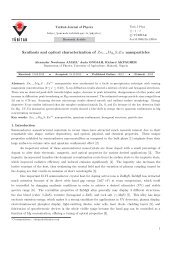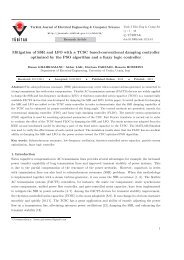Preliminary study on Acropora - Scientific Journals - Tübitak
Preliminary study on Acropora - Scientific Journals - Tübitak
Preliminary study on Acropora - Scientific Journals - Tübitak
You also want an ePaper? Increase the reach of your titles
YUMPU automatically turns print PDFs into web optimized ePapers that Google loves.
adial corallites and reticulate between the corallites, it is<br />
uniformly reticulate in the specimens of Wallace (1999).<br />
<strong>Acropora</strong> mossambica Riegl, 1995; Figures 7a–7h<br />
Material examined: Iran, Larak Island: 26°52′45.8″N,<br />
56°20′26.8″E; depth 6 m; 14 October 2008; MMTT Cnid.<br />
1323. Larak Island: 26°53′12.1″N, 56°23′32.1″E; depth 3<br />
m; 8 October 2008; MMTT Cnid. 1118.<br />
Descripti<strong>on</strong>: Branching pattern: Corymbose; branches<br />
very thick (Figure 7a); some sec<strong>on</strong>dary branches fuse<br />
to main branches at branching area, forming flattened<br />
branches; branch diameters: 10.9–13.2 mm, 8.8–13.5 mm,<br />
and 7.8–11.3 mm; branch length up to 24.2 mm.<br />
Axial corallites: Size more than twice that of radials;<br />
walls thick; round to slightly oval opening; outer diameter<br />
3.1–4.3 mm; calice diameter 1.3–1.8 mm; 1 or 2 septal<br />
cycles, poorly developed; primary septa maximum 1/3R;<br />
directive septa prominent, often touching at bottom of<br />
calice; sec<strong>on</strong>dary septa mostly absent, when present up to<br />
1/5R (Figure 7g).<br />
Radial corallites: Tubo-nariform, different sizes<br />
(Figures 7d and 7e); some corallites appressed, scattered<br />
<strong>on</strong> branches (Figure 7c); subimmersed and immersed<br />
radials more numerous at the base and between branches<br />
(Figure 7b); oval opening; outer walls thick, roughly 7<br />
times thicker than the inner walls; profile length 2–3 mm;<br />
septa poorly developed; primary septa maximum 1/5R;<br />
sec<strong>on</strong>dary septa absent or minute.<br />
Coenosteum: Costate to broken-costate <strong>on</strong> radial<br />
corallites (in most cases, costate at the tips and brokencostate<br />
at the bases of branches), sometimes densely<br />
arranged lines of laterally flattened spinules <strong>on</strong> radial<br />
corallites (Figure 7f); simple spinules between radials<br />
(Figure 7h).<br />
Color: Pale to dark brown.<br />
Remarks: So far, A. mossambica has <strong>on</strong>ly been reported<br />
in the literature from high-energy intertidal habitats in<br />
SE Africa (Riegl, 1995). Thus, finding this species in the<br />
Persian Gulf is noteworthy. For c<strong>on</strong>firmati<strong>on</strong>, a specimen<br />
of this species was sent to the Museum of Tropical<br />
Queensland, where it was identified by C.C. Wallace as<br />
<strong>Acropora</strong> cf. mossambica. Characteristics supporting the<br />
identificati<strong>on</strong> included the branch shape, size of axial<br />
corallites, and shape of radial corallites. C<strong>on</strong>sequently, this<br />
is the first report of A. mossambica from the Persian Gulf.<br />
Misidentificati<strong>on</strong> of A. mossambica as similar species, e.g.,<br />
A. selago and A. tenuis, both present in the area (Riegl,<br />
1999; Wallace, 1999), was possible. However, the larger size<br />
of axial corallites together with the differences observed in<br />
the forms of radial corallites supported the identificati<strong>on</strong><br />
as A. mossambica.<br />
Comparis<strong>on</strong> between measurements of the specimen<br />
found in the present <str<strong>on</strong>g>study</str<strong>on</strong>g> with those described by Riegl<br />
(1995) suggests that the axial corallites are narrower and<br />
314<br />
RAHMANI and RAHIMIAN / Turk J Zool<br />
Figure 7. <strong>Acropora</strong> mossambica: a) porti<strong>on</strong> of col<strong>on</strong>y; b)<br />
top view of plate; c) porti<strong>on</strong> of branch; d) SEM micrograph<br />
showing terminal part of branch; e) SEM micrograph showing<br />
close up view of radial corallites; f) SEM micrograph showing<br />
coenosteum <strong>on</strong> radial corallite; g) top view of axial corallite; h)<br />
SEM micrograph showing coenosteum between radial corallites.<br />
smaller in our specimens, but very limited details for other<br />
measurements were provided by Riegl (1995).<br />
<strong>Acropora</strong> muricata (Linnaeus, 1758); Figures 8a–8i<br />
Material examined: Iran, Larak Island: 26°53′15.9″N,<br />
56°21′02.3″E; depth 6 m; 11 October 2008; MMTT Cnid.<br />
1182. Larak Island: 26°53′15.9″N, 56°21′02.3″E; depth 3<br />
m; 11 October 2008; MMTT Cnid. 1185.<br />
Descripti<strong>on</strong>: Branching pattern: Arborescent (Figure<br />
8a) with l<strong>on</strong>g branches (maximum 160 mm), slightly<br />
tapering (Figures 8b and 8c); branches relatively thick;<br />
branch diameters: 10.0–16.6 mm, 9.7–15.4 mm, and 8.8–<br />
14.1 mm; growth determinate.<br />
Axial corallites: Axial corallites thicker and substantially<br />
larger than radials; outer diameter 2.5–3.2 mm; calice<br />
diameter 1.1–1.5 mm; calice usually not perfectly round;<br />
2 complete septal cycles present (Figure 8g); primary septa<br />
up to 3/4R; sec<strong>on</strong>dary septa up to 2/3R.<br />
Radial corallites: Two sizes, arranged spirally <strong>on</strong><br />
branches; mostly appressed tubular, some nariform, with<br />
round to oval openings (Figures 8d and 8e); subimmersed



